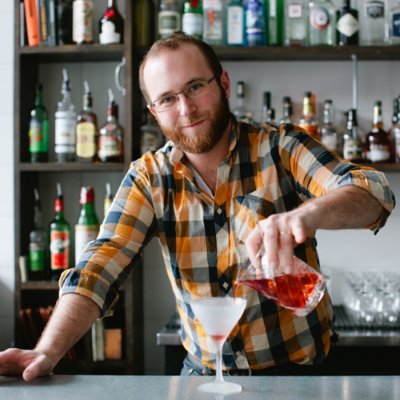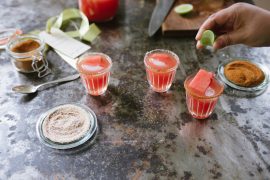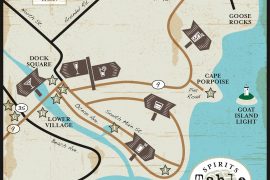Andrew Volk of Portland’s Hunt + Alpine Club shared his wealth of knowledge on all-things-gin at Table’s 2015 launch class.
Attendees at our first TABLE class of the 2015 were treated to an afternoon filled with great spirit, delicious cocktails and lessons on global history.
A history lesson you say? Why would I want to spend my precious cocktail hour learning about history?
Well friends, the truth is that booze and history cannot be separated – they are linked like the moon is to the tides.
Every distilled spirit comes with a story – wrapped in local lore that explains the narrative of our humanity.
Yes, that sounds grand… and it IS.
Andrew Volk (James Beard Nominee for Best Bar Program 2014) is a font of information and great conversationalist. The mixture of drinks paired perfectly with the primer on booze. Distiller Darren Case was in attendance to share the crafting process first-hand, and showed how he makes his New Western style of gin at Biddeford, Maine’s Round Turn Distilling.
Want to know more about gin and what Andrew Volk shared with our class attendees? You’re in luck!
A brief history of gin: (Thanks to Portland’s Hunt + Alpine Club for this information)
- According to the Beverage Alcohol Manual (BAM) of the Alcohol and Tobacco Tax and Trade Bureau (TTB), gin is:
Spirits with a main characteristic flavor derived from juniper berries produced by distillation or mixing of spirits with juniper berries and other aromatics or extracts derived from these materials and bottled at not less than 40% alcohol by volume (80 proof) - In French, juniper is genievre. In Dutch, juniper is jenever.
- The juniper bush is a member of the cypress family and has existed for over 250 million years which is why it exists in so many parts of the world.
- In the 2nd century AD, the Greek physician Galen wrote about the medicinal properties of juniper berries.
- In the 13th century, Thomas van Catimpré writes of boiling juniper berries in wine to treat stomach ailments.
- In the 17th century, Dr. Franciscus de la Boë Sylvius, a physician at the University of Leiden in the Netherlands, develops a medicine using juniper berries.
TYPES OF GIN
Jenever
- While Sylvius is credited with the origin of jenever, records show taxes levied on the product as early as 1606 and a recipe in a book from Antwerp written in the 16th century
- The Bols distillery was established in 1575 but didn’t begin making Genever until 1664, so maybe the Sylvius story was promoted to put the origin closer to when Bols started making it
- By 1685, the Dutch were exporting over 10 million gallons
- Jenever is “malt wine” flavored with juniper berries
- Malt wine is made by fermenting malted grains (rye, barley, spelt) and then performing a rough distillation of this “beer” to around 50% ABV
- The juniper berries were ground up with the malted grains and fermented with them
- When the Dutch revolted against Spain, England sent troops to assist them. The story goes that jenever was distributed to the soldiers to help them keep warm and the English loved it so much they started to call it the “Dutch Courage” and brought their taste for it back to England
- Juniper starts showing up in English distillers’ recipes in 1639
- In 1688, the King of England William of Orange (William and Mary) made jenever fashionable in England because of his being Dutch, also by banning the import of rum and brandy (foreign spirits) and encouraging English production of jenever to promote agriculture
Old Tom
- By the early 1700s, unlicensed geneva (anglicized) production was rampant throughout England and 1733, over 11 million gallons of gin were being produced just in London
- Due to high demand and total lack of regulation, most gin was cheaply made, often using turpentine instead of juniper, and had to be sweetened in order to be even remotely palatable
- By the 1720s, things were totally out of hand (the Gin Craze) leading to the nickname “Mother’s Ruin” and the five Gin Acts from 1729 to 1751 that levied heavy taxes to try to stem production and consumption and sober up the population
- As a way to avoid these taxes, a trend developed of posting a sign depicting a black cat referred to as “Old Tom” that would indicate the availability of under-the-table gin
- In some cases, there would be a small lead pipe installed under the sign and a slot for money. If you were walking by and popped in a coin, a shot of the sweetened gin would magically come through the pipe.
London Dry
- After the Gin Craze subsided, the result of the Gin Acts was to crackdown on unlicensed manufacture and encourage more licensed distilleries to be setup
- Distillation technology greatly improved with the invention of the Coffey Still in the early 1800s which allowed the manufacture of a neutral spirits on a more industrial scale
- Because of the improved taste and quality, the product no longer required sweetening to make it palatable and was thus referred to as “dry”
- This also allowed the delicate botanical flavors to come through more and encouraged more complex recipes
- In 1769, Alexander Gordon opened his first distillery and developed Gordon’s Special London Dry Gin
- The original recipe, still in use, contains juniper, coriander, angelica, liquorice, orris, orange and lemon peel
- Charles Tanqueray starting making his gin in 1830 with mostly the same recipe as Gordon’s (the two companies later merged)
- Other gin recipes from the mid-19th century include bitter almonds, sweet flag (calamus), grains of paradise, cassia, cardamom
- Use of turpentine in cheap gins persisted in both Great Britain and the US
- From the mid-19th century into the Victorian Era, “Gin Palaces” became popular in Great Britain, large ornate and gas-lit drinking establishments which might be the first “cocktail bars”
- After this golden age of cocktails, the Volstead Act (prohibition) in the US lead to a decimation of the (legal) distilling industry
- As in England during the Gin Acts, illicit production continued but this “bathtub gin” was so terrible it ruined gin’s reputation for decades to follow
New Western
- For most of the 20th century, spirit production was exclusively on an industrial scale
- There were fads for vodka and rum in the mid-century, but gin never really recovered
- In 1997, Tanqueray introduced its Malacca Gin which amped up the supporting cast of botanicals to be on more equal footing with the juniper
- In 2000, Hendrick’s was launched, a compound gin that adds the essence of cucumber and Hungarian rose petals to the distilled gin
- This process of adding in flavor essences brings these flavors into the spotlight, even diminishing the flavor of juniper
- This breaking away from the traditional London Dry recipe with its characteristic “pine tree” taste coincided with the beginning of the “Craft Distilling” movement
- Because gin doesn’t need to be aged and can be produced relatively quickly and easily, “craft” distillers began launching dozens of new gins on the market, many of them in this “New Western” style that allowed the distiller to add his or her own unique blend of flavors
- In some cases, this leads to the creation of a lower quality gin just to give a distillery something to sell while they age other products
- Visit Portland’s Hunt + Alpine Club.
- Andrew and Brianna Volk are cooking at the James Beard House on 12/4/15 for the Prohibition “Repeal Day” dinner. Find out more.
- Take a tour of Round Turn Distilling and sample their delicious Bimini Gin while you are in Southern Maine.
Find out more on culinary classes in Kennebunkport, Maine and where to stay while you are in town.




